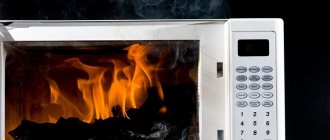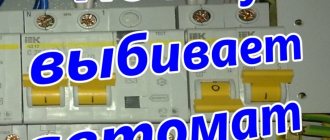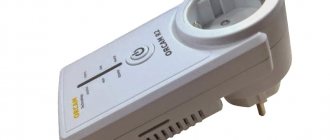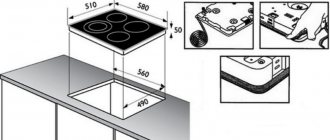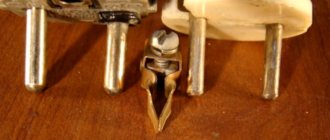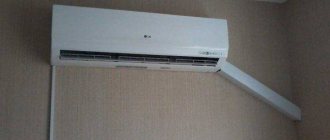What causes the socket to spark?
It is worth noting that a spark in an electrical appliance is the result of current passing from contact to contact through the air. Due to the appearance of such a mini-discharge, severe damage may occur in the wires. Their edges tend to heat up very quickly, burn and melt.
Fun fact: this phenomenon in the electrical network is akin to natural lightning, which we observe during a thunderstorm; similar to thunder is a dry crackling sound, which we will also mention.
The reasons why an outlet sparks are described in more detail below.
The plug and socket do not match the production standard. Although many use a combination of a couple of Soviet and modern parts. A striking example is the parallel use of modern Shuko plugs, which are equipped with electrodes with a diameter of 4.8 mm, with sockets that were produced back in the Soviet Union.
Well, modern devices include equipment with plugs whose electrode diameter is 0.8 mm smaller. As a result of such a discrepancy between the plug and the socket, a gap appears, which in the future can serve as a source of sparks.
Poor build quality of the device. The materials from which the product is made are of low quality.
The wires that supply voltage to the socket contacts are worn out. This phenomenon is explained by operation in conditions where the temperature regime and permissible current do not meet the required parameters.
Thus, the insulation resists less well, resulting in a violation of the integrity of the protective layer. Well, the appearance of sparks already indicates that a breakdown has occurred and this problem should be solved as soon as possible.
Loose contact of screw terminals. That is, if the connection between the wires of the electrical network and the parts of the socket is unreliable, then such a breakdown may occur while working with electrical equipment. Loosening also occurs if clamping elements are used in the structure of the device.
In this case, the pressure spring becomes weaker. Accordingly, the tightening of the screws in the screw mechanism is weakened. If you hear the socket rattling, it means the clamps are loose.
I would like to note that this phenomenon is typical for sockets in the manufacture of which aluminum wire was used. Some time after the start of operation, the so-called process of leakage of the metal itself (that is, aluminum) occurs. The result of this phenomenon is the need to periodically tighten such a connection.
Overloads in the electrical network. This can happen when a person connects an electrical appliance whose power does not correspond to the parameters allowed by a particular outlet.
A clear example of overloading is the use of extension cords and tees for single devices. And if the outlet sparks when you plug in, it's an obvious sign of overload.
Mechanical wear and loosening of contacts, which occurs when regularly changing plugs from different devices in the socket. So, what should you do if the socket sparks, but you don’t have the opportunity to replace it? Then just disassemble the device and tighten the contacts.
The appearance of soot. If you hear a crackling sound in the device, this indicates that carbon deposits have formed in it. Replace or clean the device.
The socket sparks because the plug does not fit
The most common reason that an outlet sparks is that the plug does not match the standards. Many people have had sockets since the construction of the house or the last renovation. And this is often 10 or even 20 years. At that time, these products were manufactured for electrodes with a diameter of 4 mm. Modern forks have a fork diameter of 4.8 mm. As a result of this discrepancy, it turns out that a thicker plug stretches the contacts in the socket. When you turn on a device that has 4 mm electrodes, the contact is insufficient, and therefore the socket sparks.
I would like to say that there are currently a lot of household appliances with a 4 mm plug. These include phone chargers, meat grinders, routers, and even TVs.
Consequences
If the socket sparks on its own or the appearance of sparks has one reason or another, the consequences of such a malfunction are always sad. Here are just a few of them:
- Fire in the premises.
- Electrical breakdown.
- Damage to wiring.
- Electric shock (provided that a person is using the device at the time of the malfunction).
How to fix a sparking socket is important for each of us to know. Well, even current, who does not have special knowledge and skills, can prevent a breakdown in the electrical network.
Source
Causes of sparking sockets.
Sparking occurs if the plug and socket are of different standards.
Not everyone knows that in Russia and the CIS countries two standards of plugs and sockets are used: Soviet (C) and Schuko. The Soviet standard has become obsolete and is now practically not used. The plugs and sockets of these standards have different designs, but externally they differ only in the diameter of the plug electrode. The Soviet plug has an electrode diameter of 4 mm, while the Schuko plug, which is now installed on most household and industrial appliances, as well as power tools, has a diameter of 4.8 mm. But both standards have the same distance between the electrodes, which allows them to be combined with varying success, because the difference of 0.8 mm is practically invisible to the eye.
It’s easier to forcefully insert a Schuko plug into a Soviet socket, or even bore holes in it, than to remember all these standards. And, if in this case, the electrical contact is reliable, then the reverse combination can bring problems and terrifying consequences. When installing a Soviet standard plug into a Schuko socket, due to the difference in the diameter of the electrode and the socket of the socket, sparking will certainly appear at the contact point, even under the lightest load. Depending on the load, as well as over time, sparking will cause the body of the plug and socket to melt.
If you are unlucky and you notice late that the plug and socket do not match, they are already ruined, then you can simply replace them. But to prevent this from happening, always make sure that the socket and plug are of the same standard.
Causes of sparks in an outlet
As noted in several previous publications on our website, such manifestations are characteristic of poor contact. Therefore, the reasons must be sought directly in the plug connector. List all possible options:
- Inconsistency in the standards of the main elements of the contact connector, that is, sockets and plugs.
- Connecting several powerful electrical appliances through an extension cord or tee, which leads to an electrical overload.
- Worn connectors caused by various reasons.
- Loosening of contact clamps.
- Poor quality electrical installation products, in this case sockets.
Let us consider in detail each of the listed options.
Plug and socket mismatch
Let us immediately note that this is one of the most common causes of malfunction. The fact is that the sockets are old-style, produced during the Soviet Union, designed for electrodes Ø 4.0 mm. Modern household appliances are equipped with Shuko plugs with thicker electrodes Ø 4.80 mm.
a) Soviet standard plug; c) Shucko fork
It would seem that the difference in the diameters of the electrodes of the plug design is less than a millimeter, but this leads to the fact that when you try to plug a Shucko plug into a Soviet-standard socket, you can damage the body of the latter or stretch the contact jaws. As a result, if you try to connect devices with an old plug into a given socket, sparking will be observed due to weak contact. A similar effect will be observed if a Soviet plug is plugged into a modern outlet.
Overcurrent
Like any electrical connector, a plug socket has its own characteristics that determine the permissible connection parameters. Simply put, if the permissible current of 16.0 A is indicated on the installation electrical device, then it is allowed to include electrical appliances with a total power of no more than 3.50 kW. How to calculate the permissible power from the rated current will be discussed separately.
Sparking occurs due to overcurrent.
This is one of the most common reasons why sockets fail. The rated current of the outlet is usually written on its body. But not all ordinary people understand these numbers; for most, all these amperes look like the cuneiform writing of the ancient Sumerians. And in order to correlate the power of connected electrical appliances with the rated current of the outlet, there is no need to talk about this. How to do electrical wiring yourself.
For this reason, several powerful electrical consumers are often connected to one outlet (which is why it is dangerous to use tees and extension cords), because of which the current in the outlet can exceed the rated one several times, especially with a weak outlet. In this case, the contacts heat up, their resistance increases, due to which they heat up even more. This vicious cycle leads to sparks, flames, melted sockets and plugs, and ultimately a fire.
Socket sparks due to overload
A socket, like, in principle, any other household appliance, has certain characteristics and parameters. Each product is marked accordingly. For example, a 16 A and 250 Volt outlet can withstand a load of 3.5 kW.
- 6 Amps – 1.3 kW
- 10 Amps – 2.2 kW
- 32 Ampere – 7 kW
Exceeding the maximum permissible loads will lead to overheating of the socket contacts. As a result, they burn and resistance increases. Based on this, we can conclude that a large number of extension cords and overly powerful devices cannot be plugged into one outlet.
Loose screw terminal contact.
This is relevant mainly for sockets, the power to which is supplied by aluminum wires. Aluminum is a soft metal, and over time it can itself “leak” from under the contact point, so clamp connections using aluminum must sometimes be tightened. Why aluminum cable cannot be used in electrical wiring. If this is not done in time, the contact between the socket connector and the wire will deteriorate more and more, and sparking may occur. When you touch the fork, it will intensify. It is better not to let this situation happen - all screw connections must be serviced in a timely manner.
